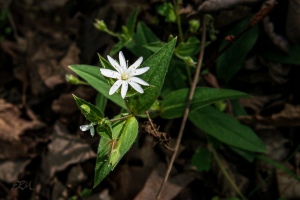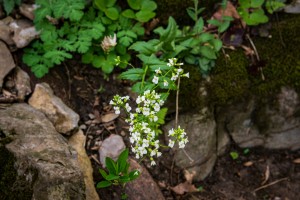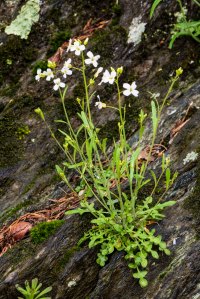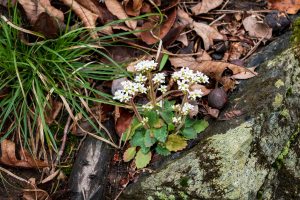Sometimes I trip across a passage that says something perfectly (or better than I could). So I’ll let botanist Chris Mattrick of the USDA Forest Service say it for me:
Members of the mustard family (Brassicaceae) are widely known for their taste, utility, and ability to become weedy, but rarely for their beauty.
After I’d written most of the previous post I realized that most of the brassicas I’ve seen in the Maryland piedmont are pretty weedy, with insignificant flowers. But there are lovely ones as well.
For most of these plants, I’ve given the older botanical names as well as the current ones, since the older names often pop up in web searches and are in some of the classic wildflower ID books.


Boechera laevigata (formerly Arabis laevigata)
Smooth rock cress is found in rocky areas in deciduous woodlands, primarily in the midwest, Appalachians and New England. It’s threatened in Massachusetts and Maine. The plant is a biennial, growing a basal rosette in the first year, with a raceme of small flowers in the second year. The flowers don’t open up much, making them inconspicuous. Mostly you’ll see the green sepals, with the tips of the white petals just peeking through.

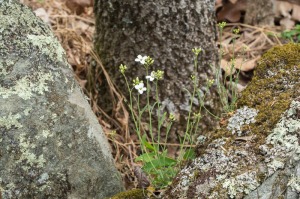
Arabidopsis lyrata
(formerly Arabis lyrata)
Lyre-leaved rock cress or sand cress is biennial or perennial with a wide range, including the Appalachians, New England except New Hampshire and Maine, the upper Midwest, much of Canada except Maritime Provinces, and Alaska. It’s endangered in Massachusetts and threatened in Ohio and Vermont. Look for it in sandy or rocky, dry to moist soils. The basal rosette of leaves is small, and the raceme slender, giving the impression of dainty white blossoms hovering over the ground. In the Potomac gorge, I see them growing right on top of rocks.
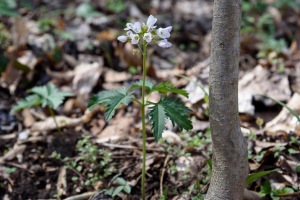

Cardamine concatenata (formerly Dentaria laciniata)
I think for many people in this area cut-leaved toothwort, also known as pepper root, is one of the highlights of spring. This species is a spring ephemeral, emerging from the ground, leafing out, flowering and dying back all in the space of four or five weeks. It’s found in the eastern half of the US and Canada, mostly in the midwest, mid-Atlantic, and New England; it’s endangered in New Hampshire and Maine. There are many species of toothwort, but this one is easily identified by the whorl of three palmately compound leaves on the flowering stem. The flowers can be pure white or have some pink or purple blush to them. Look for them in rich moist woodlands in April.

Cardamine angustata (formerly Dentaria heterophylla)
About the time cut-leaved toothwort is fading, slender toothwort will be starting to bloom. The flowers are almost identical to cut-leaved toothwort, but the two species are easily distinguished by the leaves. Slender toothwort will have two leaves at the node rather than three; these leaves are palmately compound with exceedingly narrow leaflets. The plant also puts out a wide basal leaf whose petiole is so long, you might not realize it’s part of the same plant. Slender toothwort’s range is fairly limited: it’s found mostly in parts of the south, midwest, and mid Atlantic. There are no conservation issues. Another note about trying to distinguish these two species: I’ve found many cut-leaved toothworts with only two leaves instead of three. Whether this is a response to environmental stress, or genetic, or whatever, I don’t know, but the shape and cut of the leaf doesn’t change. So if you see a plant with only one or two leaves any they look like they belong to cut-leaved toothwort, that’s what it is.

Cardamine bulbosa
Spring cress, aka bulbous toothwort, has a very similar inflorescence to the previous two species, but the basal lives are simple rather than compound and tend to be round, while the stem leaves are simple and oblong. Also, spring cress grows in moist to wet soils in some sunlight (eg, open woodlands), a slightly different habitat. It ranges from the midwest to the mid-Atlantic and somewhat into new England. It’s endangered in New Hampshire.
 Cardamine pratensis
Cardamine pratensis
This circumboreal species is known as both cuckoo flower and lady’s smock. And in some areas, meadow cress and bitter cress. Maryland Biodiversity Project has records for it in a few counties, but as I wrote a few months ago the taxonomy of this group of plants is still unsettled. At any rate, the flowers shown here were photographed in Iceland. My ID could be wrong, and I regret not having good pictures of the leaves, but this is what the flowers look like. I’ve never come across it in Maryland, where it’s listed as S1, highly state rare. It likes moist to wet soils in shady areas.
 [right and below]
[right and below]




